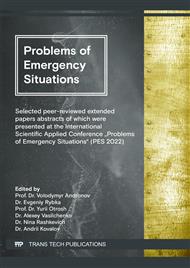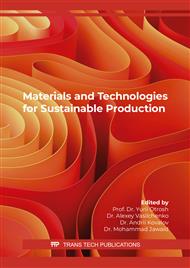[1]
Ye. O. Makarov, Ekolohichna nebezpeka vysokokontsentrovanykh stichnykh vod molokopererobnykh pidpryiemstv. Stalyi rozvytok – stan ta perspektyvy: Materialy II Mizhnarodnoho sympoziumu SDEV'2020, Lviv, (2020) 235–236.
Google Scholar
[2]
V. A. Andronov, Yu. M. Danchenko, Ye. O. Makarov, T.M. Obizhenko, Research of the regularities of forming and chemical composition of sewage water of a dairy processing company, Technogenic and ecological safety, 7 (1/2020) 13–21.
Google Scholar
[3]
G. V. Sakash, A. F. Kolova, T. Ya. Pazenko, Ochistka stochnykh vod po pererabotke moloka, Vestnik KrasGAU, 8 (2016) 97–103.
Google Scholar
[4]
T. A. Shevchenko, A. A. Shevchenko, Eksperimentalnoie issledovaniie intensifikatsii protsessa napornoi flotatsii pri ochistke stochnykh vod molokopererabatyvaiushchego predpriiatiia, Vostocho-Yevropeiskii zhurnal peredovykh tekhnologii, 1/6 (79) (2015) 4–12.
Google Scholar
[5]
M. Konevych, V. Hud, Osoblyvosti stichnykh vod molokozavodiv. Materialy XV naukovoy konferentsii TNTU imeni Ivana Puliuia, Ternopil, (2011) 309.
Google Scholar
[6]
T. Yu. Gumerov, Kompleksoobrazovaniie v protsessakh koaguliatsii I flokuliatsii belkovo-lipidnykh kolloidnykh system, Dissertatsiya na soiskaniie uchenoi stepeni kamdidata khimicheskikh nauk, Kazan, (2006) 173.
Google Scholar
[7]
Vladimir Andronov, Yevhen Makarov, Yuliya Danchenko, Tatyana Obizhenko, Colloid-chemical regularities of reagent wastewater treatment of dairies, Materials Science Forum, 1038 (2021) 235-241.
DOI: 10.4028/www.scientific.net/msf.1038.235
Google Scholar
[8]
S. B. Zuieva, I. N. Matiushchenko, E. O. Nozdrina, Osobennosti koaguliatsionnoy ochistki stochnykh vod molochnoy promyshlennosti s ispolzovaniiem filtratsionnogo osadka sveklosakharnogo proizvodstva, Voda: khimiia i ekologiia, 6 (2012) 76–79.
Google Scholar
[9]
Yu. A. Feofanov, N. L. Litmanova, Ob effektivnosti koaguliatsionnoi ochistki stochnykh vod predpriiatiy molochnoy promyshlennosti, Izvestiia Vuzov, Khimiia I khimicheskaia tekhnologiia, 48, 3 (2005) 113–115.
Google Scholar
[10]
Yu. A. Feofanov, N. L. Litmanova, Mekhanizm koaguliatsioonoy ochistki stochnykh vod oksokhloridom aliuminiia, Zhurnal prikladnoy khimii, 74, 8 (2001) 337–339.
Google Scholar
[11]
Gerson de Freitas Silva Valente, Regina Celia Santos Mendonca, Jose Antonio Marques Pereira, The efficiency of electrocoagulation using aluminum electrodes in treating wastewater from a dairy industry, Ciencia Rural, Santa Maria, 45, 9, (2015) 1713–1719.
DOI: 10.1590/0103-8478cr20141172
Google Scholar
[12]
B. Chezeau, L. Boudriche, C. Vial and A. Boudjemaa, Treatment of dairy wastewater by electrocoagulation process: Advantages of combined iron/aluminum electrodes (published online 15.07.2019), Separation Science and Technology, 15 (2019).
DOI: 10.1080/01496395.2019.1638935
Google Scholar
[13]
A. Aitbara, M. Cherifi, S. Hazourli and J.-P. Leclerc, Continuous treatment of industrial dairy effluent by electrocoagulation using aluminum electrodes, Desalination and Water Treatment, 57, 8 (2016) 3395–3404.
DOI: 10.1080/19443994.2014.989411
Google Scholar
[14]
F. Benaissa, H. Kermet-Said and N. Moulai-Mostera, Optimization and kinetic modeling of electrocoagulation treatment of dairy wastewater, Desalination and Water Treatment, 57, 13 (2016) 5988–5994.
DOI: 10.1080/19443994.2014.985722
Google Scholar
[15]
G. Varank, M. E. Sabuncu, Application of central composite design approach for dairy wastewater treatment by electrocoagulation using iron and aluminum electrodes: modeling and optimization, Desalination and Water Treatment, 56, 1 (2015) 33–54.
DOI: 10.1080/19443994.2014.934731
Google Scholar
[16]
Shariff Ibrahim, Nur Syuhaidah Mohd Aris, Borhannuddin Ariffin, Yahaya Hawari and Megat Ahmad Kamal Megat Hanafiah, Application of electrocoagulation process for decolourisation of palm oil mill effluent (POME), Nature Environment and Pollution Technology, 17, 4 (2018) 1267-1271.
Google Scholar
[17]
A. Izadi, M. Hosseini, G. N. Darzi, G. N. Bidhendi, F. P. Shariati, Treatment of paper-recycling wastewater by electrocoagulation using aluminum and iron electrodes, Journal of Environmental Heals Science and Engineering, 16 (2018) 257-264.
DOI: 10.1007/s40201-018-0314-6
Google Scholar
[18]
S. Yilmaz, E. Estra Gerek, Y. Yavuz and A. S. Koparal, Treatment of vinegar industry wastewater of electrocoagulation with monopolar aluminum and iron electrodes and toxicity evaluation, Water Science & Technology, in press (2019) 1-11.
DOI: 10.2166/wst.2019.013
Google Scholar
[19]
Y. A. Quaissa, M. Chabani, A. Amrane and A. Bensmaili, Removal of tetracycline by electrocoagulation: Kinetic and isotherm modeling through adsorption, Journal of Environmental Chemical Engineering, 2, 1 (2014) 177-184.
DOI: 10.1016/j.jece.2013.12.009
Google Scholar
[20]
M. Marugananthan, G. Bhaskar Raju, S. Prabhakar, Separation of pollutants from tannery effluents by electro flotation, Separation and Purification Technology, 40, 1 (2004) 69-75.
DOI: 10.1016/j.seppur.2004.01.005
Google Scholar
[21]
I. Zongo, A. H. Maiga, J. Wethe, G. Valentin, J. P. Leclerc, G. Paternotte, F. Lapicque, Electrocoagulation for the treatment of textile wastewaters with Al or Fe electrodes: compared variations of COD levels, turbidity and absorbance, Journal of Hazardous Materials, 169, 1-3 (2009) 70-76.
DOI: 10.1016/j.jhazmat.2009.03.072
Google Scholar
[22]
M. Changmai, M. Pasawan & M. K. Purkait, Separation and purification technology treatment of oily wastewater from drilling site using electrocoagulation followed by microfiltration, Separation and Purification Technology, 210 (2019) 463-472.
DOI: 10.1016/j.seppur.2018.08.007
Google Scholar
[23]
Yu. Yu. Lurie, Analiticheskaia khimiia promyshlennykh stochnykh vod, (1984) 448.
Google Scholar




